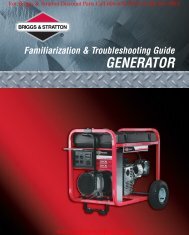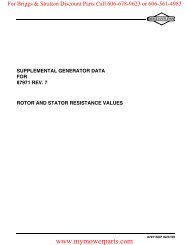GENERATOR
You also want an ePaper? Increase the reach of your titles
YUMPU automatically turns print PDFs into web optimized ePapers that Google loves.
Portable Generator Familiarization & Troubleshooting Guide<br />
Section 1 • Generator Fundamentals<br />
SIMPLE ALTERNATOR OPERATION<br />
Simple Alternator<br />
In an alternator (Figure 1.27), a revolving magnetic field<br />
called a rotor is moved through a stationary coil of wires<br />
called a stator.This movement induces an electro-motive<br />
force (EMF) into the stator coils.<br />
Figure 1.27 — Simple Revolving Field Alternator<br />
The Revolving Magnetic Field<br />
The rotor is essentially an electro-magnet.The flow of<br />
direct current (DC) through its windings creates a magnetic<br />
field around the rotor core (Figure 1.28).The strength of this<br />
magnetic field can be increased by:<br />
• Forming the rotor wires into a coil.<br />
• Increasing the wire size.<br />
• Increasing the current flow through the rotor wires.<br />
Figure 1.28 — Basic Principles Of Operation<br />
As the magnetic lines of flux cut across the stationary<br />
windings, a difference in electrical “potential” is induced into<br />
the stator windings.When a complete circuit is formed (by<br />
connecting a load to the stator windings) current flow<br />
occurs.The current (in amperes) delivered to the load is<br />
affected by:<br />
• The number of wire turns in the stator.<br />
• The strength of the magnetic field in the rotor.<br />
The Stationary Magnetic Field<br />
The number of wire turns in a stator winding are<br />
determined when it is manufactured.A typical stator<br />
assembly may be a single phase type, or a 3-phase type, as<br />
previously discussed.The greater the number of wire turns<br />
in the stator, the greater the induced EMF in the stator.This<br />
is because the magnetic field of the rotor has more wire<br />
turns to cut through on the stator.<br />
The number of wire turns in a rotor, as well as the wire size,<br />
are established when the rotor is manufactured.When the<br />
alternator is operating, you can vary the strength of the<br />
rotor’s magnetic field by increasing or decreasing the current<br />
flow through the rotor windings.Thus, by controlling<br />
current flow through the rotor windings, the EMF<br />
induced into the stator windings can be regulated<br />
and/or controlled. Because EMF (electro-motive force) is<br />
the equivalent of voltage, it can then be said that voltage<br />
regulation is accomplished by controlling rotor winding<br />
current flow.<br />
Several methods may be employed to regulate current flow<br />
through rotor windings.They include:<br />
• Direct Excitation.<br />
• Reactor.<br />
• Electronic Voltage Regulator.<br />
• Brushless/Capacitor.<br />
17






